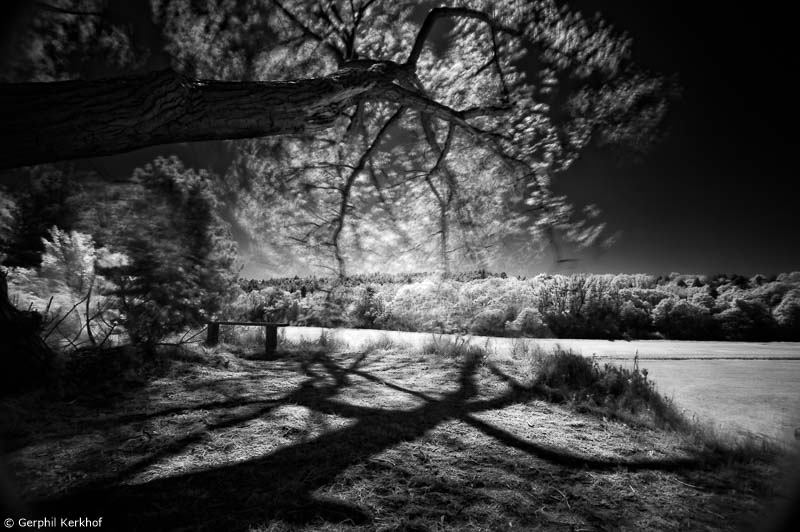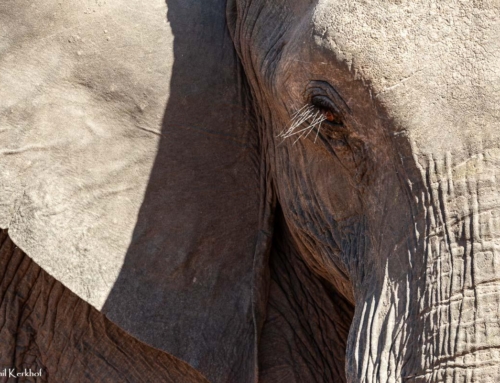People early in their burn-out or diagnosed with ADD will often feel mentally lost. Lost in a state of inner restlessness, sparsely covered by blurry distraction, staring and musing. Frantically you try to get grip on your thoughts and feelings, on your life, to get focus. But the harder you try, the further away it takes you from where you want to be.
For me this started to change when I discovered and explored a mental state that is called ‘mushin’ (Japanese for no-mind-ness). This article tells my story. Once I found the entry, at the very back end of my dreaminess and musing, it turned out to be a path to healing, meaningfulness and inner strength.
“The blurry path leads to beautiful destinations.” – Anonymous
Through the eyes of Leiter
Life started to change for me (again) in early 2012, after visiting an exhibition of the work of American photographer Saul Leiter in the Jewish Historical Museum in Amsterdam.
The visit was part of my quest to discover and develop my personal signature as an (amateur) photographer. The photography of Leiter resonated with me in a special and intense way. I was touched by its authenticity. Of course I was dazzled by the images of this very unique photographer. How he could capture incredible, unearthly beauty in what is so easily and mindlessly overlooked. However, its essence was not so much hidden in the result, as in his way of seeing.
Leiter looked at the reality around him with a completely open mind. He let himself be astounded, touched and enchanted as only children can, to whom everything is truly new. Hence, with full openness – outward and inward.
In the hours that followed, we wandered through the city to make pictures ourselves. Seeing and capturing the city as if through his eyes. It felt like a revelation to me. Like lucent dreaming, where you know that you are dreaming and yet you are completely awake and clear. Open to any detail, without filters.
Zen and the Magic of Photography
At the same time, it felt fully natural to me too. I could easily fade into it, as it was not completely new to me – just the ‘habitat’ was different. In my quest of discovering my identity/signature as a photographer I had already shifted my focus from technical and creative development to how I see and perceive reality in relationship to myself. You could rightfully say that I took a spiritual perspective here.
During that quest, which started two years before, I bumped into a book called Zen and the Magic of Photography by Wayne Rowe. The subtitle intrigued me: “Learning to See and to Be through Photography”. Especially the explanation of “Zen and the empty mind” (p.20) fascinated me:
“When thinking about a photographer’s blank state of mind when looking for images, I am reminded of the Zen concept of the “empty mind”- a mind that is awake, but fixed nowhere.”
The author makes a connection here with the Zen doctrine of ‘mushin’, a mental state of no-mind-ness that is practiced in the (ritual) sword fighting and archery of the Samurai. It requires an “empty and open state of mind with no definite plans, thoughts, desires, expectations, purposes, or ego-involvement – but where all is possible”.
Waterloopbos
Purely based on this description, I started to apply how I understood this in my photography. Initially I tried this out in a place where I could bring myself in a contemplative state easily: the “Waterloopbos”. That is a forest in the Noordoostpolder where, from the sixties to the nineties, Dutch engineers built models of significant waterworks to simulate the impact of currents and waves on coastal infrastructure, ports and the like. The area became obsolete due to better computer simulation and indoor simulation facilities. Once abandoned, these models decayed and were overgrown by nature. As the water is still flowing though the ruins and canals in the growing forest, it all adds to the mysterious, contemplative atmosphere (for my pictures of the forest, please take a look here, here and finally here).
Mushin in the woods
Here I began to teach myself to see through the world of objects, into the world of abstractions. This is how I applied the concept of mushin. I shifted my attention beyond the things, first by observing movement within the widest angle our eyes are capable of seeing. As I started to walk very slowly, I saw my perspective moving slowly too.
Trees move slowly beside you, branches slide over your head – like in a movie. As you expand your physical awareness also to include your energetic or astral body, these movements are even physically sensed, softly touching you like a tender caress. Then you start to limit your view to seeing only shades of light and darkness, the wonderful world of colors – greens and browns, the soft movement of water and weeds, sparkles of light in water drops. You start to become part of a different world that is full of magic. Soon you also start to see metaphors in everything you see too, without feeling the desire to interpret. Without wanting to know the meaning; knowing that the world is full of meaning is enough.
Now I could truly understand what Charles Baudelaire meant when he wrote his wonderful poem Correspondances.
Once in this state, making pictures was no effort, it just deepened the stillness in me. When I felt inclined to take a picture, I noticed something resonating in me. A vague sense of meaningfulness, being touched by something corresponding deep in myself. There was just wonder, no wondering why. More importantly, being ‘here’ made me feel like being very close to myself, perfectly at ease – thrilled and energized at the same time. Inspired.
citiZen
The exhibition of Saul Leiter inspired me to dare expanding this state to literally anywhere, even in a busy city like Amsterdam (see the pictures here). I noticed that I could get into ‘mushin’ pretty easily once I tried. The trick was to simply ‘shift my mind’ and ‘un-focus’ at movements and colors again. Letting myself be loosely caught by reflections in water and windows helped make this mental shift. It provided me a different perspective on ’the world of things’, including myself as an object. As if you are looking at this ‘reality’ through a peephole from a different layer, the spiritual world of meaning.
In the same period things started to shift in my life. Was it mushin or management shifts in my job or the combination? I couldn’t tell, but I slid into a near bore-out within a number of months. Losing ground in my daily job I started to I reflect deeper on myself – the themes in my photography, my emotional ‘color’ of undefined melancholy and longing (‘weemoed en verlangen’) and what is meaningful for me. Sometimes I escaped from my work, wandering through Amsterdam or elsewhere to indulge in mushin – drifting in ‘weemoed en verlangen’.
A few years later, after a period in which I regained myself somehow, the cracks in me had widened and were tested painfully. I was now broken and descended into a severe burn-out. That was three years ago.
Mushin and burn-out
Once I was burned-out and ‘depersonalized‘ from my body, I discovered that I could now enter this state even easier and significantly deeper than before. All filters were gone. In some way I could dip in it at any moment, willingly or unwillingly. Initially that was a challenging and sometimes slightly frightening experience. Yet once I accepted that this was life for the time being, my eagerness to explore this state made me hold on.
Being in this state I felt I could engage with what in myself wanted to blossom, wanted to live. I also found I could slip into ‘mushin’ wherever I was, even while driving a car on the highway; seeing and feeling movement while at the same time being fully aware of everything that is happening within my panoramic view and being touched by the music on the radio.
A few months before, just after the tipping point, I was in such a condition when I was driving through the Ardennes. In that mental state I was struck by a ‘revelation’ from deeply within what my destiny is: coaching people in their spiritual development and helping them to embody their full potential. It made me ecstatic, although I didn’t yet realize that it would imply such a painful, disruptive transformation.
Daydreaming
Recently my understanding of mushin, and notably of its therapeutic and spiritual potential, significantly deepened. As part of my process, I started a few months ago to reflect on my tendency for daydreaming, getting lost in thoughts and dissociating from where I am and from what I am doing. I have been this way all my life, even as a child. When I was at the age when classmates started to experiment with cannabis and alcohol, I thought that I didn’t need this as I considered myself as being a kind of Obelix, who fell as a baby into a kettle filled with a magic potion that gave him invincible superpowers – and me, well, being ‘high’ all the time.
ADD
As an outcome of this process, I learned a few weeks ago that I have Attention Deficit Disorder (ADD – a subtype of ADHD, without the hyperactivity). Knowing this is very helpful for me. It gives an explanation for quite a lot in my life and in my mind. It explains, amongst other things, why traditional focus-based meditation doesn’t work for me. And here we come to the meat of this article: if you are neurologically limited to fix your attention on things, either temporarily (like with a burn-out) or continuously (like with ADD or ADHD, unless you are in hyperfocus, but even that is different), traditional focus-based methods of meditation are rather impossible.
Let me first give an explanation as to why this is true for people with burn-out and/or ADHD and why we propose an “Umwertung” of the understanding of this so-called disorder or limitation. Subsequently I will proceed to explain the concept of unfocus-based meditation in more detail.
“Umwertung” the focus-impaired brain …
Your ability to steer and maintain focus is part of your so-called executive ego-functions. In neurological terms these are located in and managed from the prefrontal cortex in your brain. It is connected with other abilities like planning, prioritization, organization and in a broader sense with information processing, emotional processing and turning this all into behavior and things that make sense – like work.
When you are in a significant burn-out or if you have ADD or ADHD these abilities are temporarily or constantly obstructed. When you are burned-out, your prefrontal cortex is soaking in stress hormones, taking all the neurotransmitters away that normally allow neurons in this part of your brain to work together – in particular dopamine. Burn-out even leads to a temporary shrinking of this part of the brain.
Significantly lowered dopamine levels or a decreased sensitivity for dopamine is also related with ADD and ADHD. The same applies for an overall lower level of activity in and blood flow through this part of the brain. For ADD/ADHD-ers this means that it takes deeper emotional engagement to have this work properly in terms of attention and other ‘executive’ functions. In other words: if there is no strong engagement or interest, someone with ADD or ADHD will have a significant strain to persist in focus and concentration. We simply get distracted.
… to the unfocus-enabled mind
Another impact is a limited filtering onto ‘mind streams’, trains of sensations, thoughts and feelings. Having ADD/ADHD means that, if you would ‘open our skulls’, you would find we are constantly busy with a multitude of mind streams. Some of these mind streams we are aware of, others play in the back of our mind, in our sleep, in our daydreaming, in our subconscious – diving up and down like a bunch of dolphins. Overall, the energy vested in each of these parallel mind streams is limited, as it needs to be divided. Even the total amount of energy present in active mind streams can be drained at times. Especially ADD-ers can be more quickly fatigued because they are keeping so many balls in the air.
As a consequence, we experience often that our awareness is only sparsely filled with contemplative thoughts and undefined feelings. Sometimes our mind can even be blank for some time. If you awaken a daydreamer in the middle of his thoughts, he often cannot say what his mind was playing with. Overall, we have little control (executive function) over which of these streams comes to the forefront of our mind and which are pushed to the back or silenced.
From here it is relatively easy to slip into a mindless state.
Getting close to ‘felt sense’
Having a weak ‘captain in the middle’ means also, that our conscious is more directly integrated with our senses and with the limbic system. Here is where emotions are created and emotional memories and behavioral responses are stored. The good side of this is, that it makes us more emotional, sensitive, intuitive and impulsive than ‘normal’ people. There is limited filtering of what Gindlin calls the felt sense, allowing to engage more directly with the deeper inner wisdom or sensed meaningfulness of our body and soul.
The hidden gift
Being focus-impaired and caught in daydreaming and musing (and worrying), a constant restless inner flux of feelings and thoughts, could rightfully be regarded as a weakness. It is a significant price to pay. But there is another side that allows us to experience it as a strength too. That is why I call burn-out a blessing in disguise – and ADD as a gift.
Hunter-gatherer
This description of the unfocus-enabled mind resonates strongly with the hunter vs. farmer hypothesis that Thom Hartmann proposed in the 90s. See for example his book Attention Deficit Disorder – A Different Perception. This theory explains the evolutionary why and how the AD(H)D brain works.
Project yourself in the mind of the native hunter or warrior. See yourself traversing a dense wood searching for prey. Or imagine yourself being engaged in a fight with an unseen opponent hiding somewhere. Your vigilance needs to be wide and volatile to survive. Basically, there is no difference in mindset with either the ritual archer or swordsman practicing mushin. Nor with the photographer seeking images. You should be able to shoot straight from the spine at the very moment ‘it’ happens, without the interference of the thinking, planning, preparing mind. The eye must be fully open and alert to be able to react to anything – which requires not being fixed to single objects (or events) or expectations for certain objects (or events) to appear or happen. As soon as he would let his eyes rest on a tree it could be too late.
The mind must therefore be unfocused, aware of everything that is as one process, one Being – and how that makes itself knowable: through movements and stillness, through shades of luminosity and color, metaphors of meaningfulness. Being one with the forest, the bow, the camera, the body, one’s Self, with Being. This is the true nature of the unfocused mind of the hunter. In this mindset, quoting Bruce Lee, there isn’t even an opponent. “Because the word ‘l’ does not exist.”
From focus-based …
So how do you turn the weakness of a chaotic restless mind into a strength, into connection with Being? My answer would be in directing and shaping our focus inward. A traditional approach for this is meditation.
Your mind is normally busy with worries, things you need to do or prevent, etc. Your consciousness is chained by a constantly grasping and avoiding mind stream. The concept behind traditional focus-based meditation is to fix and focus this grasping mind on something meaningless. In this way you allow yourself to free up and expand into the unbound realm of Awareness in the widest sense. As you enter the realm of inner stillness you can engage with your deeper self, through your felt sense. This way you can open yourself up to what is really important for you now.
Moreover, this constantly grasping and avoiding mind stream also maintains the illusion of being a subject, being an ‘I’, having a constant identity. By fooling this chattering mind and lead it towards something that isn’t ‘meaningful’, like breathing, your body (bodyscan) or an object (like a Buddha statue or a candle), you can slip into that deeper state of Being.
To unfocus-based meditation
Well, for those of us who have an “attention deficit”, this gives us a hard time. Attempting to focus and fix our attention loosely on something that is fundamentally boring, is by (neuro) design rather (though not fully) impossible. It can easily make us frustrated. It confronts us with what we can’t do, reminding us of occasions when we were despised for being distracted, not there, not listening, drifting away. Just to illustrate this: being a student in “Zijnsoriëntatie” (Orientation on Being) a daily bodyscan is the foundation of your self-practice. However, for three years I have been practicing a full bodyscan, but thus far have never completed it without significant hick-ups.
On the other hand, the exploration of mushin as I see it, linking it with what it means to have ADD, gave me a surprising insight. An insight that is perfectly in line with what we teach and learn in Zijnsoriëntatie: embrace what you would like to get rid of, disengage from what you would like to hold on to. Hence, embracing my difficulty to fix focus, let it widen and roam through my complete bodily experience, allows me to move through it. To reach the other side, exactly where I want to be.
How I practice mushin … outside
Now that I have found this back-door, I can get through it at any moment, anywhere.
I can just go outside, preferably into a forest, and start walking very slowly while blurring my focus. Leaving the world of objects and entering the world of patterns, shades, concepts and meaningfulness. Enjoying the illusion of being caressed by just moving around in a very subtle connected way.
During a course in walking coaching in France, I learned to expand on this. In this version you focus first on everything that can be sensed within and onto your body while walking around. After 15 minutes, you shift your attention to everything that can be sensed (seen, but also heard and smelled) outside, similar to what I have been practicing before. Opening your senses to the fullest, without being fixed on anything. In the third quarter you combine the two, sensing all at once. This final stage gives me the experience of a boundless, non-dualistic flow and unity between the inner and outer world. A sensation that is almost ecstatic. This is now part of my coaching approach and is highly appreciated by my clients.
… and inside
However, I can also just stay at home, close my eyes and make contact with the whole of my body. Imagining that my body is a forest, a universe, where sensations can pop up and go (or not). Just being curious what makes itself known in me without paying too much attention to these sensations. After having wandered around for a while in my body, overall, attention starts to vaporize. I start to feel myself slipping away into an altered, deepened state of mind, without losing or loosening the connection with my body. Within the fading mind stream blank holes of stillness can be noticed which seem to widen without effort. Noticing these invites me to just stretch myself into these prolonging phases of no-mind-ness, like in a lazy chair. Until there is nothing but mushin.
What it brings me
The impact of this discovery is significant for me. I practice the home-version consistently for 20 minutes in the early morning, before I start to work. Then it allows to me to engage with my deepest meaningfulness, my deepest drivers – without the need to know what these are today. It helps me to proceed with the mind waves that have rolled on during my sleep. Allowing them to flow into hyperfocus, helping me to be really creative and productive that morning.
During the day inner restlessness and tension often builds up. If so, I get back to mushin again, somewhere in the afternoon. Usually that allows me to get back and stay in ’the zone’ for an extended period. Otherwise, it allows me to unfocus, refocus, or just let go – being kind to myself. Sometimes the tension has built up so much that it makes me feel melancholic or sad. Then meditating in this effortless and deep way allows me to accept these feelings and be there for myself. To be grateful for who I am and what I have done thus far.
Training
Just one caveat. It requires you to be able to use your senses to the fullest. That’s why it is still useful to learn practicing the full bodyscan and do it regularly. By alternating both methods based on what I need today, or even subsequentially, and practicing daily, I experience that I make more progress on both sides.
In particular practicing the bodyscan enables you to experience internal bodily sensations at an increasingly deeper level of detail. Sensations of tension, pressure, temperature, heartbeat, breathing, movements. Without this, focusing at your body will be a flat experience that won’t get you anywhere. Having AD(H)D gives you the advantage that your sensory cortex and your visual cortex have a greater capacity than usual. Still, you need to learn to open up and use this capacity to the fullest potential. Training this ability in both ways (focuss-based and unfocus-based) is part of my overall approach. It should be part of your daily exercise as well, at least for a while.
Tell me
I apply this approach to mushin not only personally, but also increasingly in my coaching practice. Thus far, clients have been enthusiastic about it. In particular those that are inclined to daydreaming, suffer from a burn-out or have ADD characteristics. Do you feel inspired to experiment, for meditation and personal growth or for enriching and personalizing your photography? Just give it a try (while being aware of the caveat)! I would be curious to hear your experiences.
As it allows you to engage deeper with your inner ‘meaningfulness’, you may want seek accompaniment and guidance for that. Don’t hesitate to contact me as well. I would be more than willing to go down that Path, explore those woods, with(in) you.
© Gerphil Kerkhof | november 2018
Tot slot
The idea to write this article popped up in an online conversation I started with with Lara Honos-Webb regarding her book “The Gift of Adult ADD“. As a consequence, it had to be written (by exception) in English. Quoting Wikipedia, Lara is a practicing clinical psychologist and the author of several books on attention deficit hyperactivity disorder. She is well known for her distinctive reframing of mental illnesses that are commonly conceived as detrimental, into gifts that offer exceptional strengths. She is unique in her use of radical self-acceptance in her treatment.” A vision (also referred to as neurodiversity) that strongly appeals to me.
Dit artikel legt een brug tussen een eerdere reeks over burn-out en een nieuwe reeks over dromers (en impliciet of expliciet over ADD en HSP). Wil je geen artikel missen? Abonneer je dan op mijn Nieuwsbrief – voor een bericht als er weer een publicatie is. Ben je geïnteresseerd in mijn benadering voor (Zijnsgeoriënteerde) coaching? Kijk dan hier voor wat ik voor je betekenen kan of maak een afspraak.








